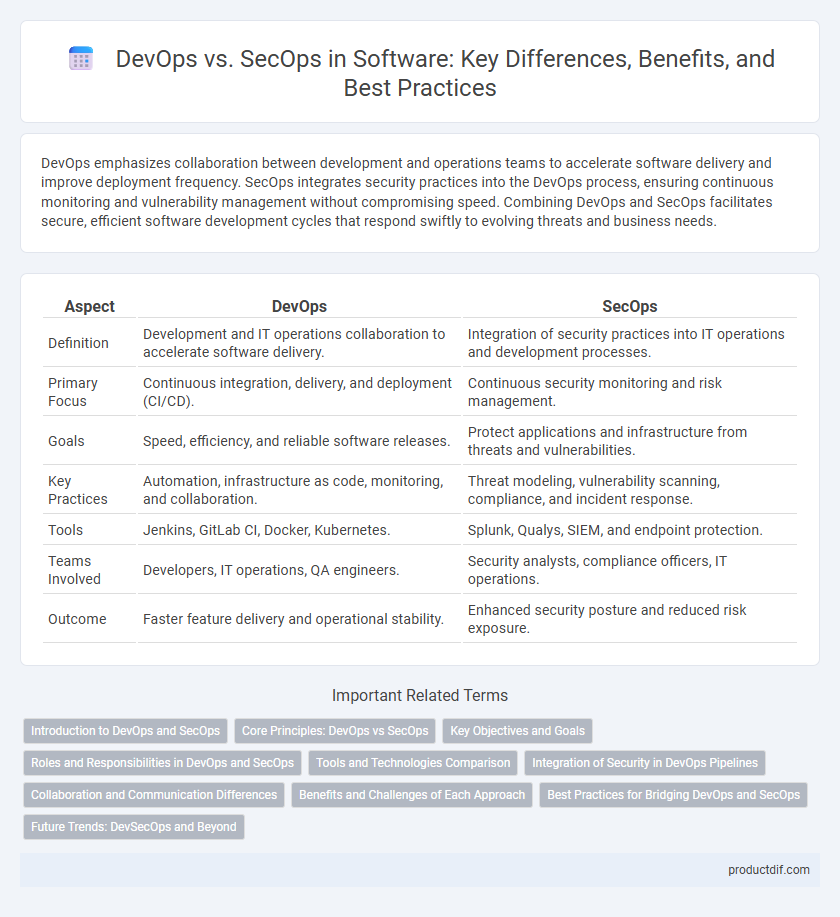DevOps emphasizes collaboration between development and operations teams to accelerate software delivery and improve deployment frequency. SecOps integrates security practices into the DevOps process, ensuring continuous monitoring and vulnerability management without compromising speed. Combining DevOps and SecOps facilitates secure, efficient software development cycles that respond swiftly to evolving threats and business needs.
Table of Comparison
| Aspect | DevOps | SecOps |
|---|---|---|
| Definition | Development and IT operations collaboration to accelerate software delivery. | Integration of security practices into IT operations and development processes. |
| Primary Focus | Continuous integration, delivery, and deployment (CI/CD). | Continuous security monitoring and risk management. |
| Goals | Speed, efficiency, and reliable software releases. | Protect applications and infrastructure from threats and vulnerabilities. |
| Key Practices | Automation, infrastructure as code, monitoring, and collaboration. | Threat modeling, vulnerability scanning, compliance, and incident response. |
| Tools | Jenkins, GitLab CI, Docker, Kubernetes. | Splunk, Qualys, SIEM, and endpoint protection. |
| Teams Involved | Developers, IT operations, QA engineers. | Security analysts, compliance officers, IT operations. |
| Outcome | Faster feature delivery and operational stability. | Enhanced security posture and reduced risk exposure. |
Introduction to DevOps and SecOps
DevOps integrates software development and IT operations to accelerate deployment cycles, enhance collaboration, and improve product quality through continuous integration and continuous delivery (CI/CD) pipelines. SecOps emphasizes the integration of security practices within operations teams, focusing on proactive vulnerability management, incident response, and compliance monitoring. Together, DevOps and SecOps streamline software delivery while embedding security controls to ensure robust and resilient applications.
Core Principles: DevOps vs SecOps
DevOps centers on continuous integration and continuous delivery (CI/CD), emphasizing collaboration between development and operations teams to accelerate software deployment and improve system reliability. SecOps integrates security practices into the operations workflow, prioritizing threat detection, vulnerability management, and compliance throughout the software development lifecycle. While DevOps focuses on automation and efficiency, SecOps ensures that security controls are embedded seamlessly to protect applications and data.
Key Objectives and Goals
DevOps aims to accelerate software delivery by integrating development and operations teams to improve collaboration, automate processes, and ensure continuous integration and deployment. SecOps focuses on embedding security practices within operations, prioritizing risk management, threat detection, and compliance throughout the development lifecycle. Both methodologies emphasize automation and monitoring but differ in their primary goals: DevOps targets speed and efficiency, while SecOps centers on safeguarding software integrity and data protection.
Roles and Responsibilities in DevOps and SecOps
DevOps focuses on roles such as developers, operations engineers, and release managers who collaborate to automate software delivery and infrastructure changes, emphasizing continuous integration and continuous deployment (CI/CD) pipelines. SecOps involves security analysts, compliance officers, and incident responders responsible for integrating security protocols, vulnerability management, and threat detection into development and operational processes. The synergy between DevOps and SecOps ensures rapid delivery cycles while maintaining robust security and compliance standards throughout the software lifecycle.
Tools and Technologies Comparison
DevOps leverages tools like Jenkins, Docker, and Kubernetes to automate software development and deployment pipelines, enhancing continuous integration and continuous delivery (CI/CD). SecOps focuses on security integration by using technologies such as Splunk, Snort, and Qualys for real-time threat detection, vulnerability management, and compliance monitoring. While DevOps emphasizes collaboration and automation to speed up release cycles, SecOps prioritizes embedding security controls and monitoring directly within the development lifecycle to mitigate risks.
Integration of Security in DevOps Pipelines
Integrating security into DevOps pipelines transforms traditional workflows by embedding automated security testing, vulnerability scanning, and compliance checks early in the software development lifecycle. This seamless fusion, often referred to as DevSecOps, enhances continuous integration/continuous deployment (CI/CD) processes, ensuring rapid release cycles do not compromise security standards. Key tools like static application security testing (SAST), dynamic application security testing (DAST), and security information and event management (SIEM) systems are crucial for maintaining robust protection within automated DevOps environments.
Collaboration and Communication Differences
DevOps emphasizes collaboration between development and operations teams to accelerate software delivery through shared responsibilities and continuous integration. SecOps integrates security practices into operations workflows, fostering communication between security and operations teams to proactively address vulnerabilities. While DevOps prioritizes rapid deployment and feedback loops, SecOps focuses on aligning security protocols with operational processes to ensure compliance and risk mitigation.
Benefits and Challenges of Each Approach
DevOps enhances software delivery speed and collaboration by integrating development and operations teams, but it faces challenges in maintaining consistent security practices. SecOps prioritizes security by embedding security measures within operations, reducing vulnerabilities but often slowing deployment cycles. Balancing these approaches can optimize development efficiency and security resilience, addressing risks while accelerating innovation.
Best Practices for Bridging DevOps and SecOps
Integrating DevOps and SecOps requires implementing automated security testing within CI/CD pipelines to detect vulnerabilities early and maintain development speed. Employing continuous monitoring and real-time threat intelligence strengthens collaboration between development, operations, and security teams, ensuring proactive risk management. Establishing shared responsibility frameworks and using Infrastructure as Code (IaC) with embedded security policies promotes unified workflows and reduces misconfigurations.
Future Trends: DevSecOps and Beyond
Emerging trends in software development emphasize the integration of DevSecOps, combining development, security, and operations into a single workflow to enhance security without sacrificing agility. Future frameworks will leverage AI-driven automation for continuous threat detection and real-time compliance enforcement, ensuring proactive risk management. Cloud-native architectures and microservices are driving the evolution of DevSecOps, enabling scalable, secure, and faster software delivery pipelines.
DevOps vs SecOps Infographic

 productdif.com
productdif.com